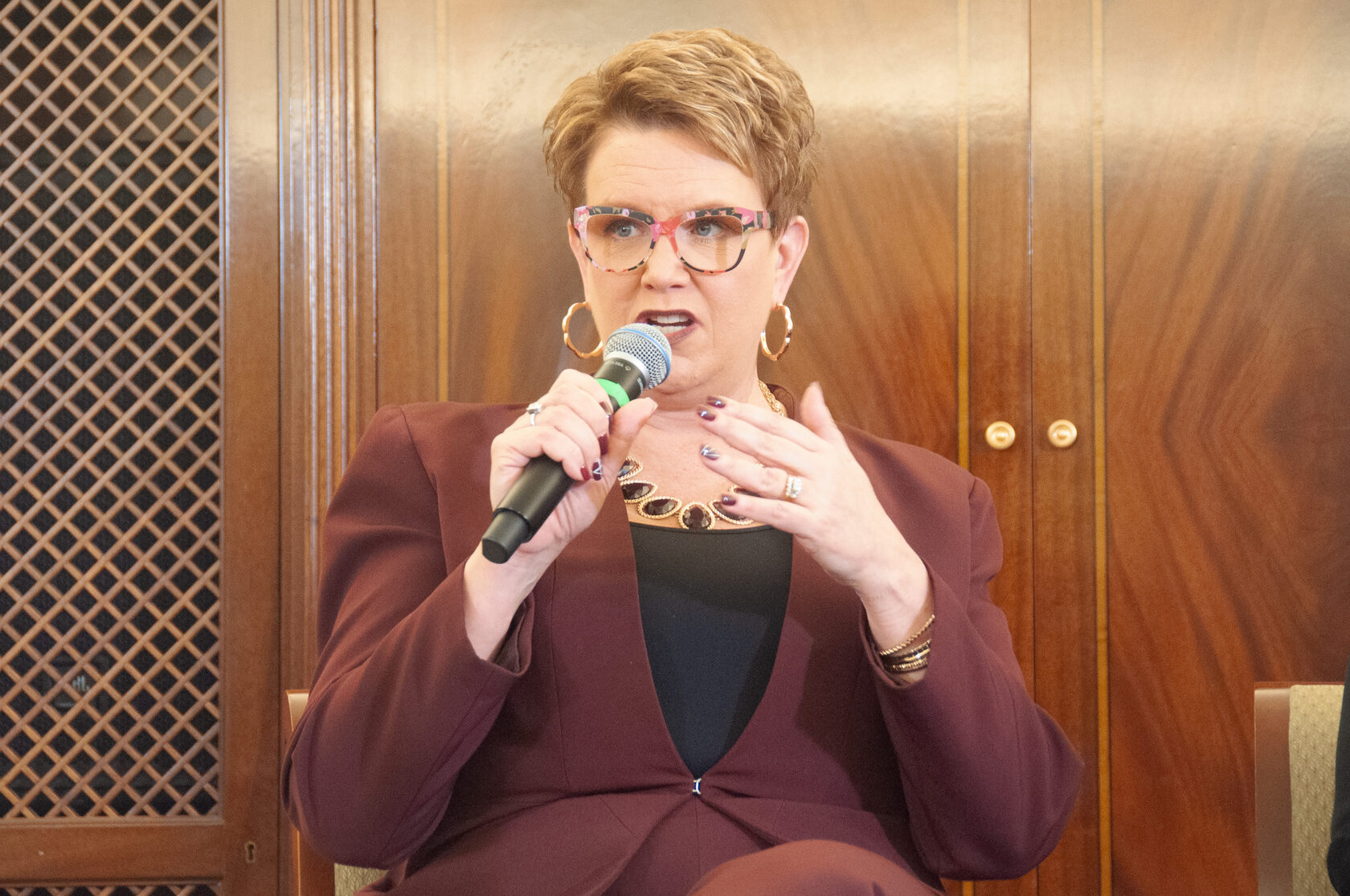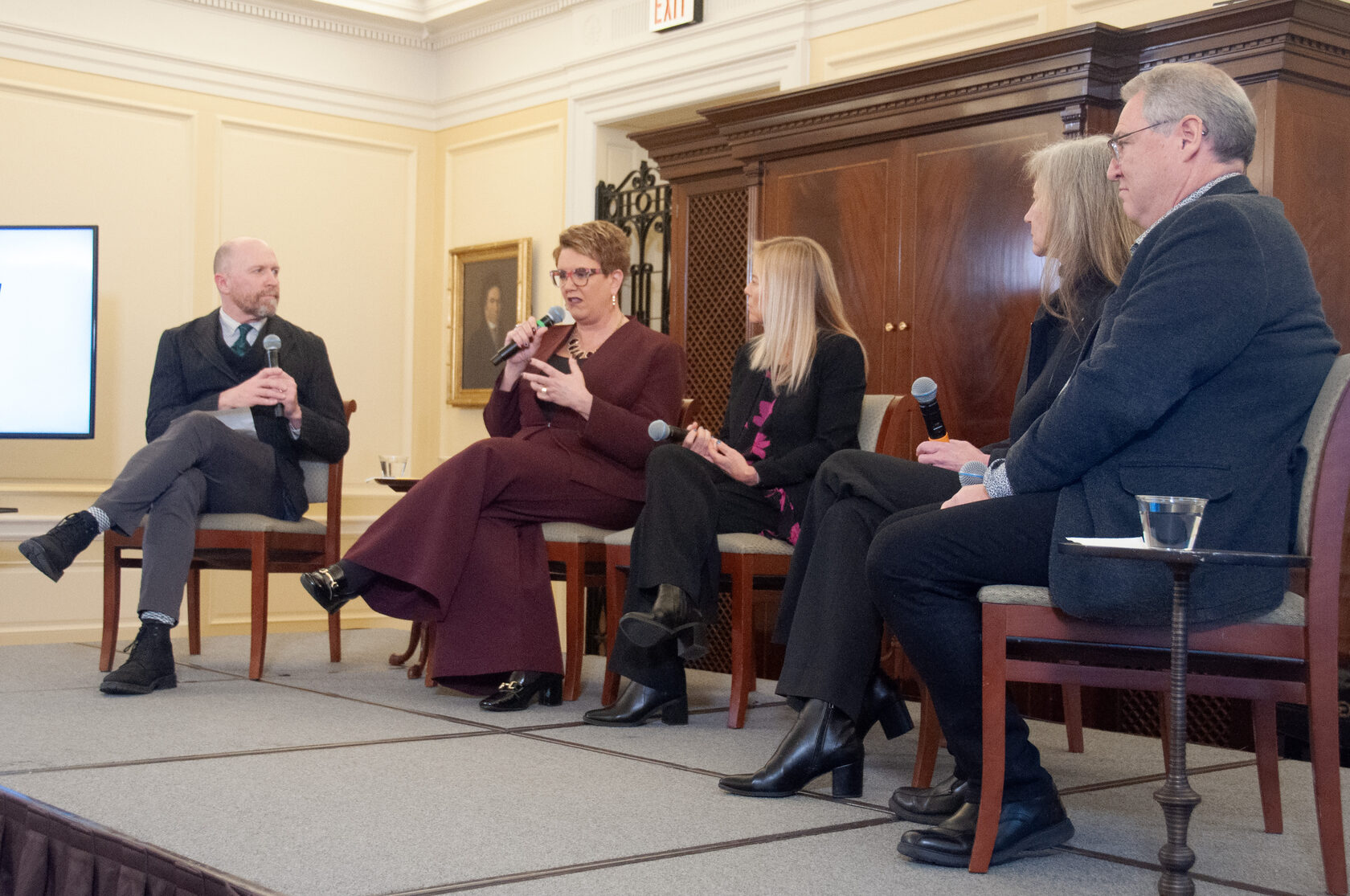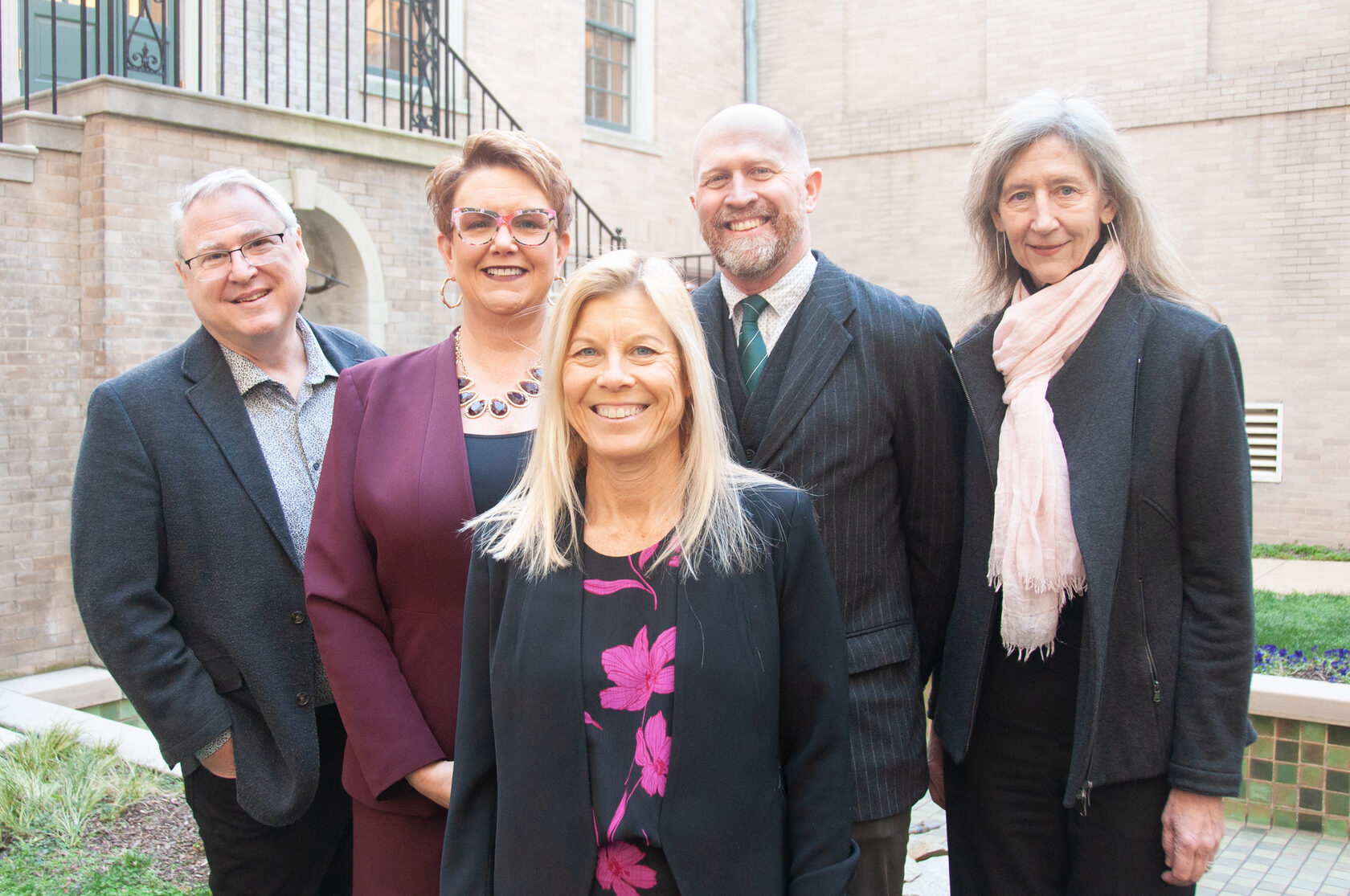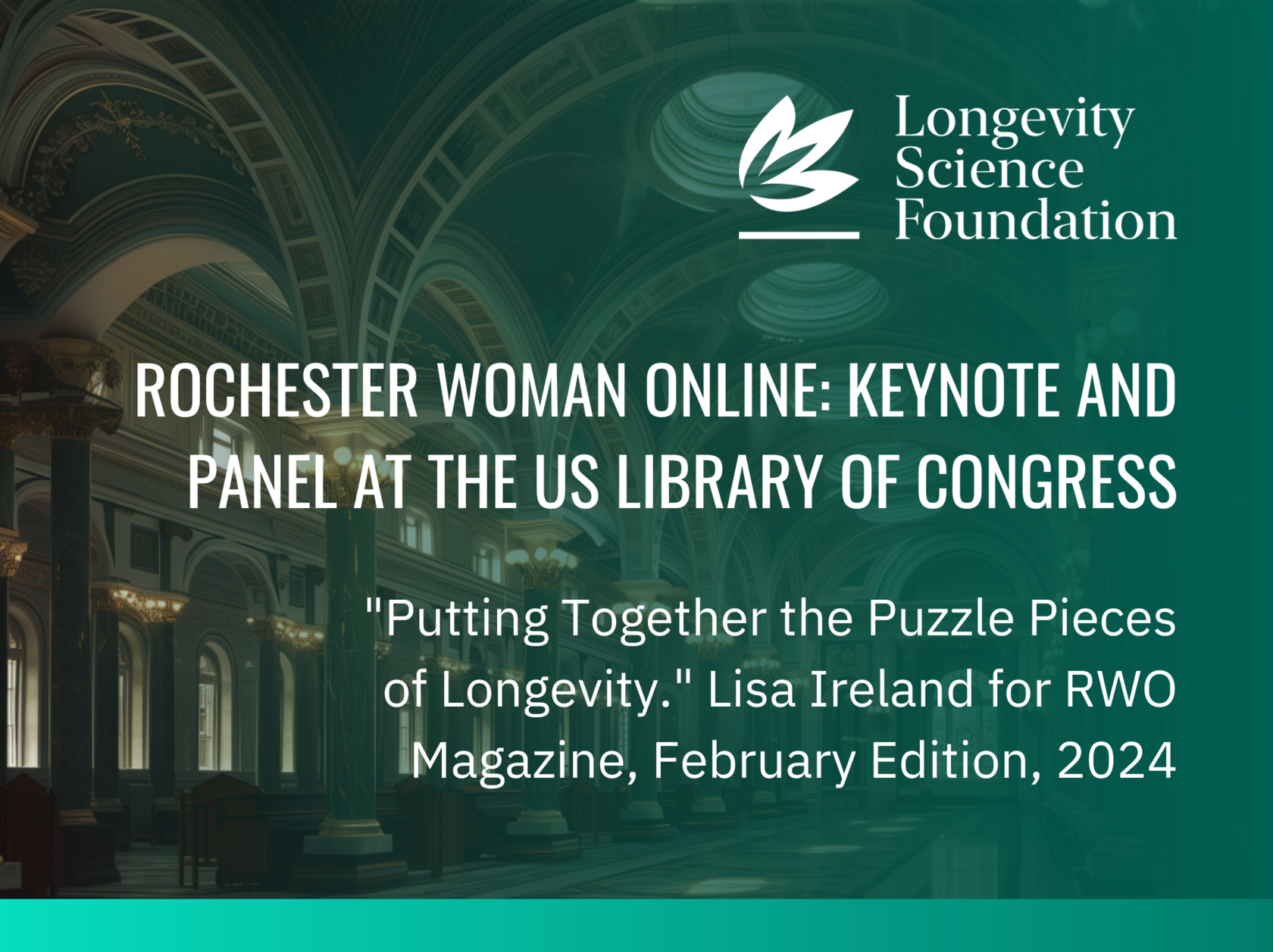Kelly Breuer's interview with Lisa E. Ireland,
President & CEO of the LSF.
First of all, congratulations on your keynote address at the Library of Congress! Can you start by sharing with us your journey into longevity science and how it aligns with the current discussions on extending both lifespan and healthspan?
Thank you, Kelly! My recent keynote address at the U.S. Library of Congress (LOC) was an incredible opportunity to highlight the essential work our organization is doing. The message of healthy aging, free of debilitating age-related diseases, resonates with everyone, and I am no exception. Like many of us, I have family members who could have lived longer and healthier lives if the science related to aging was available. At the end of the day, longevity is a matter of getting to spend more healthy years with our loved ones.
I initially graduated with a degree in communications with a minor in political science, but soon after decided to pursue a career in philanthropy, allowing me to contribute to remarkable organizations. Each step along my professional path has enabled me to impact the lives of the communities I've had the honor to serve.
In late 2022, I was approached by a recruiter, offering me the opportunity to lead a global longevity nonprofit, the Longevity Science Foundation (LSF). It didn’t take long for me to accept the position: throughout my life the idea of accessibility of resources resonated with me greatly, and I was thrilled to join the organization that pursues making longevity-care and medicine available to all. Our work centers around funding novel aging research and raising awareness about the field of longevity, and I use my skills and network to help fund aging science, democratize longevity medicine and ultimately extend the healthy human lifespan.

Lisa Ireland, speaking at the "Putting Together the Puzzle Pieces of Longevity” panel at the US Library of Congress.
How do you address the ethical considerations surrounding longevity research, particularly in terms of accessibility and affordability?
Accessibility is paramount - we’re trying to break away from the notion of longevity technology being reserved solely for the affluent and highly educated. We believe that everyone deserves a long and healthy life, free from the burdens of age-related diseases. Our collective desire to safeguard our well-being and that of our loved ones forms the essence of our mission: we aspire not just to extend lifespan, but to infuse vitality into every year we live.
We diligently seek out and evaluate promising early-stage research based on its potential impact, degree of innovation, and accessibility of the end product. It is crucial that the solutions we support are accessible to the wider scientific community and the general public, allowing everyone to benefit from their advancements.
What are some of the most promising advancements in longevity science that you find particularly exciting or impactful?
Predictive diagnostics and personalized treatments play a vital role in promoting healthy longevity by combating and even preventing the progression of serious illnesses. One area that deserves particular attention is biomarkers of aging: a diverse range of parameters that aid in monitoring age-related changes and predicting the onset of pathologies.
These biomarkers encompass a variety of factors, including telomere attrition (1), epigenetic alterations (2), loss of proteostasis (3), deregulated nutrient-sensing (4), mitochondrial dysfunction (5), cellular senescence (6), stem cell exhaustion (7), genomic instability (8), altered intercellular communication (9), disabled macroautophagy (10), chronic inflammation (11), and dysbiosis (12).
Biomarkers have proven indispensable in assessing one's biological age. Now, there are tools called “aging clocks” that enable the assessment of these biomarkers and the determination of biological age. Accessible and precise aging clocks show immense potential in tracking, mitigating and potentially reversing biological aging. Recognizing their significance, the Longevity Science Foundation has focused its grant call on aging clocks. We welcome our readers to learn more about our efforts in supporting the groundbreaking research on aging clocks.
Could you elaborate on the intersection between longevity science and neural health, and the potential implications for cognitive function and brain aging?
Neural health is a cornerstone of healthy aging. Debilitating, neurodegenerative diseases such as Alzheimer's or Parkinson’s severely compromise our health and well-being. We cannot achieve healthy longevity on a large scale without addressing these issues, and I was glad to delve deeper into this intersection during the panel discussion at the LOC with Kelly O’Brien, the vice president for Prevention at UsAgainstAlzheimer’s.
While there are numerous ways in which neural health influences our health and lifespan, at the Longevity Science Foundation, we have chosen to spotlight its frequently overlooked and stigmatized aspect: psychological well-being. Earlier in the fall of 2023, we closed a grant call focusing on the convergence of psychological health, biological aging, and psychedelics. There is a reason why the LSF turned our attention to psychedelic compounds: these substances have emerged as promising tools for addressing complex and treatment-resistant psychological conditions. Moreover, there is substantial evidence to suggest that psychedelic compounds hold potential for neural regeneration, offering new pathways for understanding the complexities of brain health and functionality.
We eagerly anticipate the outcomes of our grant reviews, confident that the research projects selected for funding will bring the scientific community closer to mitigating neural health afflictions, whether they be diseases classically associated with cognitive impairment (Bell’s Palsy, Alzheimer’s, etc.), or psychological conditions, such as personality disorders and depression.

"Putting Together the Puzzle Pieces of Longevity” panel at the US Library of Congress.
Left to right: John Fenn, Lisa Ireland, Kelly O’Brien, Susan Magsamen and Jon Kay.
In your opinion, what role do public policy and government initiatives play in supporting longevity research and its translation into practical interventions?
Policymakers play a huge role in helping longevity research and technologies reach practical applications. Currently, aging is not looked at as a disease-like process, hindering the translation of research findings into clinical practice. We are a long way from having aging classified as a legitimate, multifactorial disease within the existing frameworks. However, through collective efforts and political action, we can make strides by urging governments to prioritize citizen health and acknowledge the necessity for federal investment.
One effective approach when engaging with policymakers is to frame the issue of unhealthy aging as a substantial financial burden on our economies. The financial repercussions of unhealthy aging are apparent: the rise of the population aged 60 and above brings about a surge in age-related ailments ranging from Alzheimer's to atherosclerosis and glaucoma. A growing proportion of aging individuals contend with multiple chronic conditions; in the United States alone, nearly half of the older population grapples with two or more. It is easy to see how the treatment of these diseases places escalating pressure on the American healthcare system.
Fortunately, there has been some progress on this front: a year ago Congressman Gus Bilirakis and Congressman Paul Tonko announced the Congressional Caucus for Longevity Science. This move has already sparked similar initiatives across the world, giving enough optimism to believe that the movement will gain momentum, bringing nations together in our joint fight against biological aging.
What are some misconceptions or myths about longevity science that you encounter, and how do you debunk them?
One myth that I tend to encounter a lot is the belief that there exists (or will exist) a magic pill, a silver bullet that will eradicate the detrimental consequences of biological aging. Aging is a multifaceted phenomenon, characterized by interconnected mechanisms that are not fully understood. Moreover, everyone possesses vastly diverse biological and genetic profiles, rendering a one-size-fits-all solution improbable.
Another misconception is that longevity science is reserved exclusively for billionaires, leaving ordinary individuals like you and me with no prospect of achieving healthy aging. Even though not entirely unfounded, numerous projects worldwide are underway to enhance accessibility of longevity interventions and medicine.
At the 2023 Aging Research and Drug Discovery Meeting in Copenhagen, our scientific advisor and director of the Center for Healthy Longevity (CHL) at the National University Health System in Singapore (NUHS), Dr. Andrea Maier, announced the launch of a healthy longevity clinic in a public hospital. In May of the same year, another groundbreaking initiative was announced: the opening of the Sheba Longevity Center at Sheba Medical Hospital - a public longevity clinic, led by Dr. Evelyne Bischof, the chair of our Scientific Advisory Board.
These are just some of the projects directed at democratizing the field, enabling broader public access to longevity treatments and technologies. The Longevity Science Foundation proudly stands alongside other longevity and aging-research nonprofits, confident that our work will contribute to advancements capable of enhancing everyone’s healthy longevity. However, our readers can also take steps to promote their healthy aging: maintaining consistent exercise, adopting healthy eating habits, and adhering to regular sleep patterns have an enormous influence on one’s well-being.
Can you discuss the importance of interdisciplinary collaboration in longevity research, and how it contributes to innovation and progress in the field?
Our industry unites a variety of disciplines, drawing together professionals from the life sciences, healthcare, longevity advocacy, and medical technology sectors. Researchers use various approaches to address different facets of aging, including gene therapy, geroprotectors, diagnostic tools, and personalized medical-care solutions.
This highlights the breadth and intricacy of the central challenge we are trying to address: biological aging. It also underscores the need for a longevity ecosystem, one that facilitates the development of actionable roadmaps and cohesive frameworks to expedite progress and consolidate the efforts of numerous talented individuals dedicated to fighting biological aging. One notable collaborative venture in this regard is the Biomarkers of Aging Consortium, funded by our colleagues at the Methuselah Foundation.
Substantial collaborative strides have been made within the field of longevity medicine. I am proud to highlight our Scientific Advisory Board once again: over a year ago, Dr. Maier and Dr. Bischof founded the Healthy Longevity Medicine Society — an international medical association of physicians and aligned professionals — aimed at promoting unified standards, fostering collaboration, and explaining the practices of longevity medicine. Dr. Bischof, together with the fellow Scientific Advisor of the LSF, Dr. Alex Zhavoronkov, and their colleagues, created an educational platform for longevity physicians called the Longevity Education Hub, designed to familiarize interested parties and students with the “latest advancements in biogerontology, geroscience, and precision medicine.”

"Putting Together the Puzzle Pieces of Longevity” panel at the US Library of Congress.
Left to right: Jon Kay, Lisa Ireland, Kelly O’Brien, John Fenn and Susan Magsamen.
What are the key challenges facing longevity research today, and what strategies are being employed to overcome them?
While the field is rapidly developing, it contends with significant obstacles, slowing the overall progress and decelerating the clinical transition of many promising solutions. One such obstacle that comes to mind is the very problem that lies at the inception of the LSF: the low survivability of fundamental scientific research due to inadequate early-stage funding. Between the conception of a research proposal and the stage at which its outcomes become viable for venture capital exists a critical gap - the space where “good ideas go to die”.
Many research teams lack the funds needed to translate their findings into useful therapies and interventions, which ultimately deprives us of scientific progress. Even though pre-translational research is the backbone of innovation in the industry, it struggles to secure non-dilutive funding due to heavy bureaucracy and limited sources. As a result, we miss out on many groundbreaking discoveries that researchers could have saved many lives. Moreover, one direct consequence of underfunded research is the unequal access to longevity medicine, therapies, and treatments.
Finally, what also presents a big challenge is the fact that aging isn’t looked at as a disease-like process, which, as mentioned earlier, greatly impedes clinical translation of research discoveries into actionable, real-life applications.
How do you engage with the public and raise awareness about longevity science, its potential benefits, and the need for continued research and investment?
Increasing public awareness is paramount, and we must strive to enhance the accessibility of information. When I just took on the role of the president and CEO of the LSF, I was struck by the vast amount of information available, much of which will be daunting for the average person seeking to learn more about anti-aging endeavors. To succeed, we need broader engagement, ensuring that our message rings clear and resonates with people outside of the field. This is one of my top priorities: having worked with STEM-focused nonprofits like the RMSC (Rochester Museum & Science Center) and the Rochester Institute of Technology (RIT), I know the impact that layman’s education can make, and I regularly communicate with both leading researchers and interested parties, be that prospect donors or just family and friends, trying to shed more light on the great work that is being done in the field. Besides that, my frequent travels and speaking engagements at various events and conferences provide ample opportunities to engage with international audiences. My keynote address at the LOC serves as a recent example, and judging from the reactions and the numerous requests to connect, the LSF is heading in the right direction.
The entire field is committed to expanding its outreach. Dr. Zhavoronkov, the aforementioned scientific advisor of the LSF, exemplifies this dedication. In 2013, he authored the book titled "The Ageless Generation: How Advances in Biomedicine Will Transform the Global Economy." His work has been followed by publications from other key-opinion leaders in the longevity community, including "Lifespan: Why We Age – and Why We Don't Have To" by Dr. David Sinclair in 2019, "Outlive: The Science and Art of Longevity" by Dr. Peter Attia in 2023 and other amazing works that explain the science behind human longevity and emphasize the critical importance of optimizing healthspan.
Access the full RWO February 2024 edition here.
